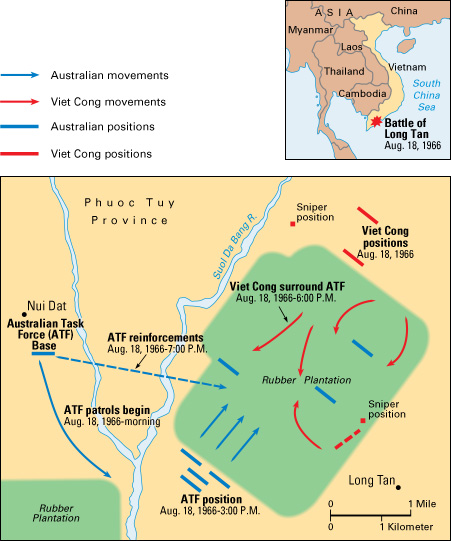Long Tan, Battle of, was an important battle of the Vietnam War (1957-1975). It took place on Aug. 18, 1966, in the southern part of what is now Vietnam. During the war, Vietnam was divided into Communist North Vietnam and non-Communist South Vietnam. In the Battle of Long Tan, Australian troops defeated a much larger force of Viet Cong troops, who were reinforced by soldiers from the North Vietnamese Army. The Viet Cong were Communist-led South Vietnamese guerrillas. Long Tan was a village near the battlefield.
Background.
Australia’s opposition to Communism and support for the United States led to its involvement in the Vietnam War. In 1962, Australia sent military advisers to South Vietnam. The first Australian troops followed three years later. In 1966, the government increased Australia’s commitment to the war and sent its first drafted soldiers.
In April 1966, the Australians began to set up an operational base at Nui Dat, about 3 miles (5 kilometers) west of Long Tan. The base was about 70 miles (110 kilometers) east of Saigon (now Ho Chi Minh City), the South Vietnamese capital. On the morning of Aug. 17, 1966, the Viet Cong fired artillery at Nui Dat. The Australians then sent out soldiers to find the Viet Cong.
The battle.
On August 18, an Australian group searched for the Viet Cong at a rubber plantation near Long Tan. The group, led by Major Harry Smith, consisted of 105 Australians and 3 New Zealanders. At about 3:40 p.m., the Australians battled a small group of Viet Cong. About half an hour later, the Australians encountered the main body of Viet Cong troops. Experts estimate that the Viet Cong numbered more than 2,000.

In a monsoon rain, Smith’s force fought the Viet Cong. American and Australian forces supported Smith’s company with artillery fired from the base at Nui Dat. During the battle, two helicopters braved the rain and enemy fire to resupply Smith’s troops. The Australians stopped several waves of Viet Cong attacks. Around 7:00 p.m., after about 3 hours of fighting, additional Australian troops reinforced Smith’s company. Nightfall and the arrival of reinforcements ended the battle.
The aftermath.
Over the course of the Battle of Long Tan, the Australians suffered 17 killed and 24 wounded. In addition, one of the wounded soldiers died from his injuries a few days later. After the battle, the Australians buried 245 Viet Cong soldiers found on the battlefield. However, captured documents indicated that hundreds more Viet Cong were killed or wounded. United States President Lyndon B. Johnson awarded Smith’s company the Presidential Unit Citation for their courage.
In 1969, Australian soldiers raised the Long Tan Cross at the battle site to commemorate the battle. After the war, local villagers removed the cross. In 1989, the local government placed a replica cross at the site of the battle. In 2002, the Australian Veterans’ Vietnam Reconstruction Group (AVVRG) restored the replica cross and memorial site with assistance from the Australian and Vietnamese governments. The AVVRG (now the Australia Vietnam Volunteers Resource Group) undertakes humanitarian projects in Vietnam.
The Long Tan Cross is one of only two memorials permitted in Vietnam that honors a former enemy. The other commemorates the 1954 Battle of Dien Bien Phu, in which Vietnamese revolutionaries defeated colonial French forces.
Australia’s Vietnam Veterans Day is commemorated annually on August 18, the anniversary of the battle.
